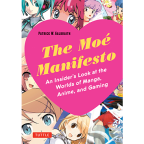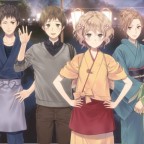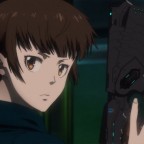Young Animator Training Project 2012 Short Films Review
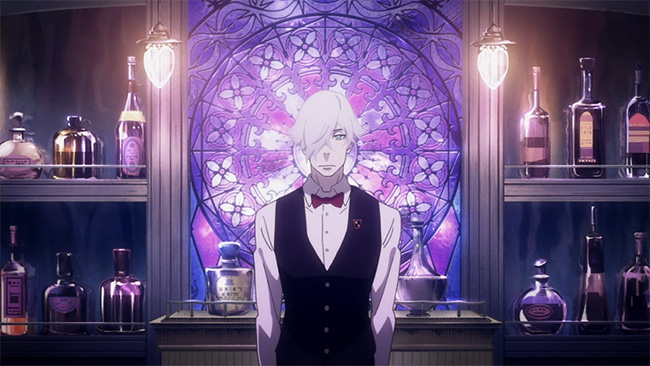
I’ve recently watch the four short anime films that took part in the young animator training project 2012. So were they any good? And what exactly is this project?
Before we get to the reviews themselves let me explain what the young animator training project is. The young animator training project is s an annual project created by the Japanese Animation Creators Association (JAniCA). The project, launched in 2010, is funded by the Japanese government’s Agency of Cultural Affairs in order to support training animators. So basically each year JAniCA receives funds from the Agency of Cultural Affairs, which are then used to train young animators. These funds are not distributed equally among the studios – each studio must bid on the funds based on an original animation they propose with an emphasis on indeed having the intent to train young animators throughout it. The young animator training project is sometimes referred to as Project Mirai (not to be confused with the 3DS game featuring Hatsune Miku). There are multiple reasons behind the inception of the project:
- The popularity of anime is rising but the low income, long working hours and tight schedule caused by the grueling digitalization process of modern anime are discouraging new people from becoming animators in Japan.
- As Japan’s distinct anime directors and animators are growing old in age the anime industry is rapidly approaching an age where qualified world-renounced animators are not around anymore. In this context it becomes urgent to draw fresh promising new talents into the fray.
- The cost-cutting practice of outsourcing parts of the animation process to other countries is harming the workflow in Japan, effectively preventing young Japanese animators from receiving “on the job” training. The young animator training project implicitly restricts the studios to produce their works in Japan to strengthen the human bonds within the studios.
As you can see from these pointers the young animator training project is a constructive way to prevent the Japanese anime industry from losing its artistic, visual and unique cultural edge. When the project comes to a close each year the animation shorts are broadcasted in Japan (on TV, in a limited theatre run and on NicoNico Douga) but never reach the West. It really is sad since some of these shorts are begging to be introduced to the world in one form or the other. What’s more, the only way to get a hold of any of these after they are broadcasted, even within Japan, is to pirate them.
Now that you know the nitty-gritty details behind the project let’s have a look at the animation shorts the project has yielded this year.
Death Billiards (studio Madhouse)
 A young man and an elderly man find themselves in a strange bar and cannot seem to remember when or how they ended up there. The bartender soon explains that they are imprisoned in this place and must play a game with their lives at stake if they want to leave. After the two hapless souls agree to the bartenders conditions the game of billiard is chosen to decide their fate. But this is no ordinary billiard – each ball has an image of an organ inscribed into it, and these organs are synchronized to move or pulsate with the players’ real organs! The future of the two will be decided by this morbid game of death billiard.
A young man and an elderly man find themselves in a strange bar and cannot seem to remember when or how they ended up there. The bartender soon explains that they are imprisoned in this place and must play a game with their lives at stake if they want to leave. After the two hapless souls agree to the bartenders conditions the game of billiard is chosen to decide their fate. But this is no ordinary billiard – each ball has an image of an organ inscribed into it, and these organs are synchronized to move or pulsate with the players’ real organs! The future of the two will be decided by this morbid game of death billiard.
Death Billiards is a gloomy and gripping short, reminiscent of low-profile dark series like Shigofumi and Ballad of a Shinigami. The reason behind the two men’s arrival to the bar and the purpose behind the billiard game are slowly explained during the course of the film. Visually this short doesn’t fall from any other high production film and the short playtime actually plays in favor of it – giving each and every revelation an edgy two-faced meaning. All the characters have…well real character! That includes the poker-faced bartender and his (somewhat more motivated) female assistant. The film’s only flaw comes in the form of the emotional tantrums the younger participant in the game often resolve to. This melodramatic approach somewhat goes against the cool flow of the film. But it’s also a staple of anime as a whole which leads me to believe that the inclusion of these emotional outbursts was something forced on the animators by their more stiff supervisors. The pacing, camera angles and story are rock solid. Some parts were intentionally left untold for us to ponder and analyze. In short, Death Billiards is a cunning and surprisingly deep short film that left me very satisfied and hungry for more.
Aruvu Rezuru, Mechanized Fairies (Zexcs)
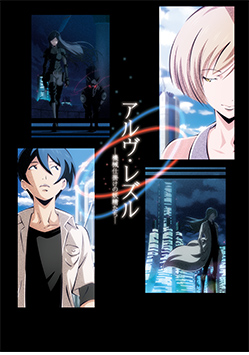 In a futuristic world where floating cities and military robots exist a young boy called Mikage Remu discovers that his sister Shiki lives inside a “body pool”. “Body pools” are tub-like devices that take care of every bodily need – enabling the person inside to study or work without worrying about their physical and worldly needs. She invites her brother to join her in an online life simulator called Next Life where she often plays in her spare time. Shortly afterwards a large scale incident occurs, causing 52,535 players of Next Life to lose consciousness and become plants. All the victims were using the body pool system, and Shiki is one of them. Three months after the incident Remu learns that his sister regained consciousness and goes to visit her. But as it turns out the souls of many incident victims were mixed in cyberspace, returning into bodies that aren’t their own. Shiki thinks she isn’t Remu’s real sister, but can’t remember who she was. Then, when the two are attacked by vicious mechanical dogs Shiki exhibits high hacking and fighting skills. Remu decides to help her uncover the nature of the attacker in the hope of finding out more information on his sister’s condition.
In a futuristic world where floating cities and military robots exist a young boy called Mikage Remu discovers that his sister Shiki lives inside a “body pool”. “Body pools” are tub-like devices that take care of every bodily need – enabling the person inside to study or work without worrying about their physical and worldly needs. She invites her brother to join her in an online life simulator called Next Life where she often plays in her spare time. Shortly afterwards a large scale incident occurs, causing 52,535 players of Next Life to lose consciousness and become plants. All the victims were using the body pool system, and Shiki is one of them. Three months after the incident Remu learns that his sister regained consciousness and goes to visit her. But as it turns out the souls of many incident victims were mixed in cyberspace, returning into bodies that aren’t their own. Shiki thinks she isn’t Remu’s real sister, but can’t remember who she was. Then, when the two are attacked by vicious mechanical dogs Shiki exhibits high hacking and fighting skills. Remu decides to help her uncover the nature of the attacker in the hope of finding out more information on his sister’s condition.
Unlike Death Billiards, Aruvu Rezuru, Mechanized Fairies falls really short. The execution, on all levels, feels amateurish at most. The writing is terrible. The story feels like a rushed first episode for a series that we will never see (and frankly don’t even feel intrigued to see). But worst of all – Remu and Shiki’s relationship slowly but surely drifts into the vague realm of brother-sister incest. It’s blatant otaku bait served cold. Perhaps the young animators and script writers working on this project felt they had to insert some otaku substance even at the expense of making the film less believable. I was disappointed by Aruvu Rezuru, to say the least. It feels more like a cheap parody of a bad action show from the 90s than a promising first step into the realm of anime production. Better luck next time Zexcs.
Little Witch Academia (Trigger)
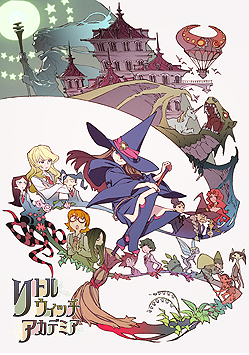 Inspired by the extravagant witch Shiny Chariot Akko Kagari joins the witch academia even though she doesn’t come from a family of witches. In the academia she befriends and shares a room with the docile Lotte and the creepy Suushy – both of which come from witch families. Akko knows her lack of knowledge in wizardry is keeping her behind the other students but isn’t bothered by this fact. What does bother her is that the other little witches seemingly unanimously think Shiny Chariot is a charlatan who soils the dignity of witches. After embarrassing herself in broom-flying class Akko resolve to prove her skills in the dangerous sport of dungeon crawling. But when another witche unknowingly releases a magic-devouring dragon who was confined in that same dungeon it falls on Akko and her classmates to prevent their academia from total annihilation.
Inspired by the extravagant witch Shiny Chariot Akko Kagari joins the witch academia even though she doesn’t come from a family of witches. In the academia she befriends and shares a room with the docile Lotte and the creepy Suushy – both of which come from witch families. Akko knows her lack of knowledge in wizardry is keeping her behind the other students but isn’t bothered by this fact. What does bother her is that the other little witches seemingly unanimously think Shiny Chariot is a charlatan who soils the dignity of witches. After embarrassing herself in broom-flying class Akko resolve to prove her skills in the dangerous sport of dungeon crawling. But when another witche unknowingly releases a magic-devouring dragon who was confined in that same dungeon it falls on Akko and her classmates to prevent their academia from total annihilation.
Little Witch Academia has the look, feel and sound of a Disney film. It has Western influence written all over it and even features a castle with fireworks in the background (talk about not very subtle references!). The plot itself is quite plain, so if you were looking for a typical anime title you’ll probably be disappointed. But you shouldn’t be, because Little Witch Academia has three great things going for it: full animation, a vast world and pure fun. Why full animation? Because unlike you typical anime LWA doesn’t make use of limited animation. Instead it uses full and fluid motions. Everything except mouth flaps is delightfully animated, usually fairly accurately (I write “fairly accurately” since some of the character designs are deformed). In comparison to the previous two titles I covered LWA also portrays a much bigger world with more characters, a big academia that provides a variety of backgrounds and even some hints at an ecosystem that exists between non-magical humans and witches. Lastly Little Witch Academia is just pure fun to watch. It is of the wacky, light, sort of cartoon that you enjoy for being the colorful energetic thing that it is. Although I can’t quite put an anime label on Little Witch Academia it’s clear that the animators, script writers and director behind this short are talented people. I enjoyed watching Little Witch Academia, probably more than I should have.
Update: Little Witch Academia is now streaming in English for free on YouTube. You can watch the entire short here. A big thanks goes to Trigger for making it available so soon!
Ryo (Gonzo)
 The year is 1866, amidst the Ch?sh? rebellion. Sakamoto Ryouma – the mediator who brought the forces of Satsuma and Ch?sh? to work together – adopts an orphaned child. He names him Ryo and makes him his right hand and servant. The two spend their days together, fighting off shinsengumi soldiers who often try to take their lives. Until one night they are betrayed and Ryo’s happy days come to a sad end.
The year is 1866, amidst the Ch?sh? rebellion. Sakamoto Ryouma – the mediator who brought the forces of Satsuma and Ch?sh? to work together – adopts an orphaned child. He names him Ryo and makes him his right hand and servant. The two spend their days together, fighting off shinsengumi soldiers who often try to take their lives. Until one night they are betrayed and Ryo’s happy days come to a sad end.
Ryo is by far the most conservative and traditional animation short of the four. It shows a glimpse of how people lived right before the Meiji restoration, but that’s about all it does. There are only two characters – Ryo and Ryouma – and there is no story to be told here. The film juggles between mundane scenes of Ryo and Ryouma shopping in the city (for lack of better description) and light action sequences in which they fight dispatched Shinsengum samurai. While great details went into portraying the pre Meiji lifestyle the sword fights in Ryo are over the top unrealistic samurai fare. Ryo drags a bit in the beginning and doesn’t have a conclusive ending. It all amounts to a sour experience that most will frown upon. This film wasn’t planned correctly on the storyboard level so the management of time, character interactions and story elements are all uneven. While it is arguably more professional than Aruvu Rezuru it strives to achieve far less and does a poor job even at that. Albeit its short length Ryo isn’t really worth your time.


